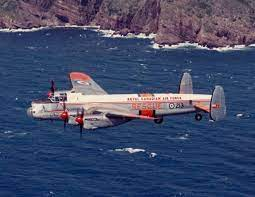In what was described in some circles as "A good day for the RCAF" the Government of Canada officially announced plans to replace its fleet of CP-140 Auroras with Boeing’s P8-A Poseidon. According to a press-released issue by National Defence in November of 2023 Canada has finalized a government-to-government agreement with the United States for the acquisition of up to 16 P-8A Poseidon aircraft for the Royal Canadian Air Force. Fourteen multi-mission aircraft will be procured, with options for up to an additional two. It was announced that the first P-8A should be delivered in 2026, and with an average of one aircraft delivered per month, all of the aircraft could be delivered as early as fall 2027. The government anticipates full operational capability by 2033.
These aircraft, if procured, will join a surprisingly long list of aircraft operated by the RCAF in the maritime reconnaissance role since World War II.
Following the end of the Second World War, Lancaster MK 10 bombers served with the RCAF in several roles. During the 1950s, the RCAF operated seventy heavily modified Lancasters, designated Lancaster 10MR/MPs, as Maritime Reconnaissance and Patrol aircraft in an anti-submarine role. The Lancasters served throughout the 1950s, when they were supplemented by the Lockheed Neptune until replaced by the Canadair Argus.
P2V-7 Neptunes, later designated as CP-122's served in the anti-submarine, anti-shipping, and maritime reconnaissance roles as a stopgap between 1955 and 1960 pending deliveries of the Canadair CP-107 Argus. Twenty-five Neptunes served with 404, 405 and 407 squadrons until 1960.
The thirty-three CP-107 Argus produced by Canadair replaced the last of the Avro Lancasters as well as the Lockheed Neptunes in the 1960's. It was one of the most effective anti-submarine warfare aircraft of its day and a mainstay for the RCAF.
Replacing the Argus was the Lockheed CP-140 Aurora, introduced into service in 1980, it is a maritime patrol aircraft based on the Lockheed P-3 Orion. A total of twenty-one airframes in two different variants were procured.
Busy in the cold war era to support Canada's anti-submarine warfare mission obligations under NATO for the northwest Atlantic sector, as the CP-140 moved into the 21st century the aircraft have increasingly been employed for domestic and international surveillance for security, counter-terrorism and smuggling, as well as to monitor foreign fishing fleets off Canada's coasts. CP-140s have also been deployed on operations such as Operation Assistance and Operation Apollo.
The Aurora Incremental Modernization Project (AIMP) began in 1998 to upgrade the electronics mission systems and sensors, currently, the Aurora Structural Life Extension Project (ASLEP),approved in 2008 and completed in 2020, updated and replaced structural components of the aircraft. A total of 14 aircraft were so modified and remain in service.
So, seventy Lancasters, supported by twenty-five Neptunes, were replaced by thirty-three Argus aircraft which in turn were replaced by, originally, twenty-one Auroras, which will be replaced by ''up to sixteen'' P8-A Poseidons. ''Up to'' is a bit of misdirection here, given that Boeing will probably close the production line for these aircraft due to lack of orders, fourteen will almost certainly be the maximum number of Poseidons in Canadian service.
This is not so much "A good day for the RCAF" as it is just another step in a downward spiral.
Some will argue that modern aircraft can travel faster and have better sensors, what is seldom mentioned is that the targets they are searching for are also faster, have better sensors and are often stealthier than their forbearers. It is also true that, like all aircraft that came before them, even the most modern of platforms can not be in two places at the same place.
Given that the Air Force will need, even in the most optimistic of planning scenarios, two aircraft being used for training or in maintenance for every aircraft available for actual service this means that, at most, Canada will have four or five aircraft available to monitor the longest coastline in the world as well as meeting external treaty obligations and any of the, to be expected, ''unexpected'' demands for these valuable platforms.
A Good Day? Not really




